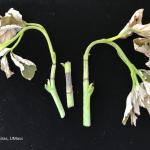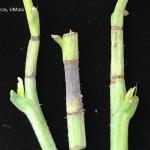Raspberry IPM- Raspberry Cane Borers
The raspberry cane borer (Oberea bimaculata, AKA O. perspicillata) is one of two species of cane borers that can affect raspberry plantings. Significant infestations can reduce fruit yield. Fortunately, the type of damage these beetles cause is very distinctive, so their presence in the field is easy to detect.
Life cycle
Adult female raspberry cane borers chew two rings of holes in raspberry canes and lay an egg inside the stem between the rings. After hatching, the larvae begin feeding on cane pith and work their way downward through the center of the cane. The larvae are white with brown heads, lack legs, and are about three quarters of an inch long. They overwinter inside the cane not far below the lower ring of holes. In spring they resume eating and continue downward until they reach the plant crown, where they spend their second winter. The larvae pupate the following spring. Adults emerge during the summer months, commence feeding on the surfaces of new canes, and lay eggs.
Signs and Symptoms
The damage caused by raspberry cane borers is very distinctive. The two rings of holes made by female borers are often visible to the naked eye. The plant tissue between the rings eventually dies and the shoots above this point will wilt. If you see the growing tips of canes dying back, look for the two rings of holes just below the wilted parts. They are roughly 1 inch apart, and the cane often breaks easily at this point.
Management
Cultural/Biological
- Scout raspberries at least once a week in June and July for signs of cane borers. Look for the two rings of holes below any wilted tips.
- Pruning and destroying symptomatic canes several inches below the lower ring is the most effective way of managing this pest. Infested canes should be burned or disposed of far from the growing site.
- Eliminate wild Rubus species from the vicinity of the planting as thoroughly as possible.
Chemical
- Pesticides are generally not recommended for this pest.


